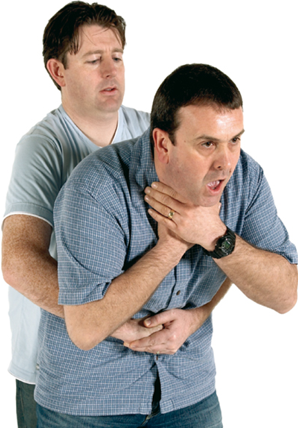 We’ve all most probably watched Mrs Doubtfire, and remember the scene where the children, their mother and Pierce Brosnan are sat down for dinner in a restaurant. Pierce’s character swallows a king prawn and begins to choke before being saved by the main character, but how true to real life could this be?
We’ve all most probably watched Mrs Doubtfire, and remember the scene where the children, their mother and Pierce Brosnan are sat down for dinner in a restaurant. Pierce’s character swallows a king prawn and begins to choke before being saved by the main character, but how true to real life could this be?
What is Choking?
 First, let’s look at what choking is; a type of airway obstruction caused by food or another object which prevents a person from breathing properly, as clearly outlined in the scene above. When we teach the subject during First Aid training courses, we discuss the possible signs and symptoms displayed by a choking person, several of which are reflected in the film.
First, let’s look at what choking is; a type of airway obstruction caused by food or another object which prevents a person from breathing properly, as clearly outlined in the scene above. When we teach the subject during First Aid training courses, we discuss the possible signs and symptoms displayed by a choking person, several of which are reflected in the film.
- Clutching at the throat
- Gagging
- Inability to speak breathe or swallow
What Should You Do When Someone Chokes?
 But moving away from the Hollywood depiction, when someone is choking with a completely blocked airway, no oxygen can enter the lungs. The brain is extremely sensitive to this lack of oxygen and begins to die within four to six minutes. It is during this time that first aid must take place as irreversible brain death can occur in as little as 10 minutes. So what should you do?:
But moving away from the Hollywood depiction, when someone is choking with a completely blocked airway, no oxygen can enter the lungs. The brain is extremely sensitive to this lack of oxygen and begins to die within four to six minutes. It is during this time that first aid must take place as irreversible brain death can occur in as little as 10 minutes. So what should you do?:
- Ask them if they are choking, whilst this may sound counter-intuitive if they can speak breathe or cough, they may be able to clear their own throat. This also tells us that the choking is mild. Encourage them to cough to try and clear the obstruction themselves, do not administer back blows or give them anything to drink. If they can’t cough, then the obstruction is severe, and we need to take action.
- Stand behind, or just to the side of the casualty, support them across the chest and administer 5 back blows, pausing between each one to see if the obstruction has dislodged. If this fails to remove the obstruction, we will need to perform abdominal thrusts.
- Stand behind the casualty and put your arms around their waist. Place one hand in a clenched fist between the belly button and the bottom of the chest, with the other grasp your fist and pull inwards sharply. Check their mouth in between each thrust. Perform this technique up to five times.
- If the obstruction has still not dislodged summon emergency medical assistance and repeat the cycle of back blows and abdominal thrusts until either the obstruction is removed, emergency services arrive, or the casualty becomes unconscious.
- Should your casualty become unconscious be prepared to start CPR.
If you would like to become a certified First Aider, get in touch with WA Management to book into an expert and affordable Emergency First Aid training course! We also have our affordable and easily accessible CPR Essentials Online Training course that provides the basic knowledge required to perform CPR.
By Neil Ward, Training Consultant at WA Management

